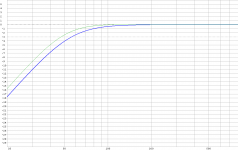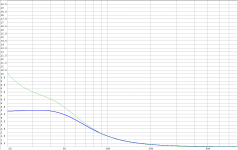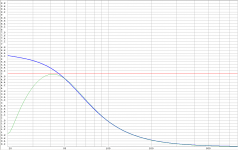I have Yamaha NS-1000M speakers in my stereo setup along with 2x Arendal 2.5 Subwoofers which go to ~18Hz. Yammies have modified crossovers; Class A SET-tube amp is driving berylliums and Luxman poweramp is driving woofers. minidsp handles the active crossovering. dSpeaker antimode 2.0 handles frequency response up to 200Hz.
I was twiddling with signal generator yesterday and noticed that those 12dB/octave sloping woofers eat up 20Hz but obviously, producing little sound (but lots of heat I guess!). Since I do not want to damage my cones, what type of highpass filter should I program to minidsp to prevent woofer from possible damage but still preserving PRaT?
Afaik -3 point of 1000m woofer is ~50Hz and it slopes down 12dB/oct due to its closed box design.
I was twiddling with signal generator yesterday and noticed that those 12dB/octave sloping woofers eat up 20Hz but obviously, producing little sound (but lots of heat I guess!). Since I do not want to damage my cones, what type of highpass filter should I program to minidsp to prevent woofer from possible damage but still preserving PRaT?
Afaik -3 point of 1000m woofer is ~50Hz and it slopes down 12dB/oct due to its closed box design.
You could try a passive line level filter, ie between source and preamp and see if you can hear the PRaT difference?
If anything noticeably messes up "PRaT", it's broken.
To the OP, if you add a Butterworth 12dB/octave filter at 50Hz, you'll have an LR4 acoustic curve with a -6dB point of 50Hz. Should be nice and easy to integrate the subs to.
Chris
Try 20Hz Butterworth 2nd order. At less than half your -3db point it should have only very small audible impact. Maybe nudge it up to 25Hz if it's not obtrusive.
Will try!
To the OP, if you add a Butterworth 12dB/octave filter at 50Hz, you'll have an LR4 acoustic curve with a -6dB point of 50Hz. Should be nice and easy to integrate the subs to.
Chris
Hmm, you sure about this? I read a review where it was emphasised that closed enclosure of 1000m produces accurate bass because of its 12dB/oct slope and thus lowQ (0.5). Would LR4 mess up this?
Subs are being integrated beautifully already with dSpeaker antimode
nopeA port tuned to 20hz.
Last edited:
nope
I understand the gut reaction ("I don't want to screw the beautiful, tight bass I have"), but it wasn't a bad suggestion at all.
I modeled it for you - look at the frequency response, group delay and cone excursion (with 50W input) below.
Porting the cabinet that low (20Hz) does not significantly alter the response anywhere audible (>40Hz), while it does provide additional protection from over-excursion between 15 and 40Hz.
Below 15Hz there won't be any input to excite the woofer anyway, so it shouldn't matter (except if you use vinyl, then you should really have a subsonic filter in place...)
Marco
Attachments
Yep, i've done it with my own diy speakers based on the Vifa M21WG-09-08. They started life in a sealed box but now ported at 18hz and the bass sounds the same but with a touch more depth. They will also go louder without distortion.
Please read my original post. Adding port to my speaker, (especially to NS-1000M) is suboptimal solution at best. NS-1000M is designed to be overdamped closed box and have accurate bass. Its distortion is very low already. I could understand protecting woofer with port only if one cannot use active crossovers. But with active crossovers you don't even need to unnecessarily feed your amplifier with a signal that is not audible anyway.
What I was asking was ACTIVE way to protect woofer since I alreade have minidsp in signal line.
Will try!
Hmm, you sure about this? I read a review where it was emphasised that closed enclosure of 1000m produces accurate bass because of its 12dB/oct slope and thus lowQ (0.5). Would LR4 mess up this?
Subs are being integrated beautifully already with dSpeaker antimode
If you want to protect the speakers from very low frequency signals, you need to add another layer of filtering. Since you're running a MiniDSP, it ought to be pretty easy to try adding the filter and see what you think.
That said, if you're happy with how the system sounds at the moment (ie, the only sign of trouble is when you play a full-level 20Hz sine tone), my advice would be to stop worrying! Direct-radiating speakers will tell you if they're distressed.
Chris
Please read my original post. Adding port to my speaker, (especially to NS-1000M) is suboptimal solution at best..
So you've never tried it. The simulations say it will improve things with no negatives but you know best. Fair enough, you want to do it with dsp but for anyone else who's reading this and hasn't got a closed mind, try it. It's not "a suboptimal solution" at all.
So you've never tried it. The simulations say it will improve things with no negatives but you know best. Fair enough, you want to do it with dsp but for anyone else who's reading this and hasn't got a closed mind, try it. It's not "a suboptimal solution" at all.
I'm afraid you're mistaken.
A ported box will reduce cone excursion around the port tuning frequency, but the woofer is no longer protected by the cabinet air-spring. Below the port tuning, it will flap around a lot more than the sealed box, meaning damage is actually more likely.
Check your work by extending the frequency axis to 10Hz.
Chris
I'm afraid you're mistaken.
A ported box will reduce cone excursion around the port tuning frequency, but the woofer is no longer protected by the cabinet air-spring. Below the port tuning, it will flap around a lot more than the sealed box, meaning damage is actually more likely.
Check your work by extending the frequency axis to 10Hz.
Chris
Correct. But, there is no input at 10Hz to begin with, in a fully digital front end!
With vinyl there is, as I said before, and then active filtering is required.
I’d be inclined to trust that the original designers at Yamaha had good reasons for going with sealed, and wouldn’t second guess them. The NS1000, or even the 690 and 670 had to my ears very well balanced performance across their entire range- certainly more so than some of the larger ported Marantz multi-ways that we’re in the showrooms when I was in retail in the mid - late 70s.
Richie00boy’s numbers probably couldn’t hurt.
Richie00boy’s numbers probably couldn’t hurt.
I’d be inclined to trust that the original designers at Yamaha had good reasons for going with sealed, and wouldn’t second guess them. The NS1000, or even the 690 and 670 had to my ears very well balanced performance across their entire range- certainly more so than some of the larger ported Marantz multi-ways that we’re in the showrooms when I was in retail in the mid - late 70s.
Richie00boy’s numbers probably couldn’t hurt.
Those Marantz multi-ways probably employed Woofers with very different Thiele-Small parameters, housed in Reflex boxes tuned much higher (I'd guess around 40Hz).
Bottom line: you shouldn't automatically assume that all bass-reflex alignments sound the same ;-)
Correct. But, there is no input at 10Hz to begin with, in a fully digital front end!
Sure there is. Church organ CDs, recording studio mistakes, etc etc.
I have a spectrum analysis of a close-mic'd kick drum somewhere. 16Hz is -3dB on 32Hz.
Chris
Whether porting is best or not, these are legendary and expensive speakers, and opting to cabinet is going to slaughter their monetary value. So in this case electronics is the solution. An electronic solution will also protect the voice coil, porting can never do that.
Last edited:
Whether porting is best or not, these are legendary and expensive speakers, and opting to cabinet is going to slaughter their monetary value. So in this case electronics is the solution. An electronic solution will also protect the voice coil, porting can never do that.
Thought this was obvious, but I'd only suggest a port if someone was going to build new cabinets, or if there was somewhere on the cabinet that could be used as a port without damaging anything (L-pads holes?).
Why would you need to protect the voice coil? Are the voice coils known to be easily damaged on NS1000s?
- Status
- This old topic is closed. If you want to reopen this topic, contact a moderator using the "Report Post" button.
- Home
- Loudspeakers
- Multi-Way
- Protecting Yamaha NS-1000M woofer with active high-pass filter?


